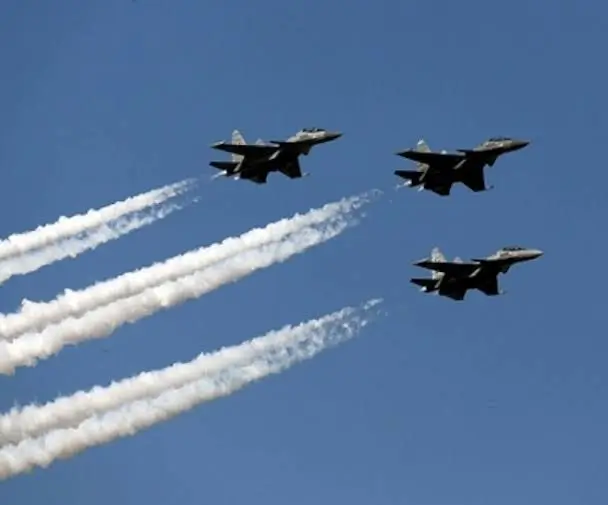Why do Military Aircraft often fly in formation?
Military aircraft often fly in formation for several reasons, which include:
Tactical Advantage
Flying in formation provides tactical advantages during combat operations. Formation flying allows for better coordination between aircraft, facilitating communication, situational awareness, and the ability to execute complex maneuvers effectively. By flying in close proximity, military aircraft can concentrate their firepower, provide mutual support, and enhance their defensive capabilities.
Mutual Protection
Formation flying provides mutual protection for aircraft. The close proximity allows for faster response times and immediate support in case of an attack. It increases the chances of detecting threats and enables coordinated defensive maneuvers, such as evasive actions or countermeasures deployment.
Improved Efficiency
Formation flying can enhance fuel efficiency and extend the range of aircraft. By flying in close formation, aircraft can reduce drag and take advantage of the aerodynamic benefits of drafting. This can result in fuel savings and longer operational endurance, which is especially crucial for military missions that require extended flight durations.
Training and Skill Development
Formation flying is an essential component of military pilot training. Pilots learn how to maintain precise positioning and spacing, communicate effectively, and operate as a cohesive unit. Formation flying skills are critical for air combat situations and aerial displays, where precise coordination is necessary.
Visual Deterrence and Symbolism
Formation flying can have a psychological impact by visually representing strength and unity. Military aircraft flying in formation during public events or airshows can serve as a demonstration of military power, teamwork, and national pride.
It’s important to note that while formation flying has its advantages, it also requires significant training, skill, and strict adherence to safety protocols to ensure the safety of the pilots and the aircraft involved.
सैन्य विमान अक्सर गठन में क्यों उड़ते हैं?
सैन्य विमान अक्सर कई कारणों से निर्माण में उड़ान भरते हैं, जिनमें शामिल हैं:
सामरिक लाभ
गठन में उड़ान भरने से युद्ध संचालन के दौरान सामरिक लाभ मिलता है। फॉर्मेशन फ़्लाइंग विमानों के बीच बेहतर समन्वय, संचार की सुविधा, स्थितिजन्य जागरूकता और जटिल युद्धाभ्यास को प्रभावी ढंग से निष्पादित करने की क्षमता प्रदान करती है। निकटता में उड़ान भरकर, सैन्य विमान अपनी मारक क्षमता को केंद्रित कर सकते हैं, पारस्परिक सहायता प्रदान कर सकते हैं और अपनी रक्षात्मक क्षमताओं को बढ़ा सकते हैं।
पारस्परिक सुरक्षा
फॉर्मेशन फ़्लाइंग विमान के लिए पारस्परिक सुरक्षा प्रदान करती है। निकटता किसी हमले की स्थिति में त्वरित प्रतिक्रिया समय और तत्काल सहायता प्रदान करती है। यह खतरों का पता लगाने की संभावना को बढ़ाता है और समन्वित रक्षात्मक युद्धाभ्यास को सक्षम बनाता है, जैसे कि टालमटोल वाली कार्रवाई या जवाबी कार्रवाई की तैनाती।
बेहतर दक्षता
फॉर्मेशन फ़्लाइंग से ईंधन दक्षता बढ़ सकती है और विमान की रेंज बढ़ सकती है। नज़दीकी संरचना में उड़ान भरकर, विमान ड्रैग को कम कर सकते हैं और ड्राफ्टिंग के वायुगतिकीय लाभों का लाभ उठा सकते हैं। इसके परिणामस्वरूप ईंधन की बचत और लंबे समय तक परिचालन सहनशक्ति हो सकती है, जो विशेष रूप से सैन्य अभियानों के लिए महत्वपूर्ण है जिनके लिए विस्तारित उड़ान अवधि की आवश्यकता होती है।
प्रशिक्षण और कौशल विकास
फॉर्मेशन फ़्लाइंग सैन्य पायलट प्रशिक्षण का एक अनिवार्य घटक है। पायलट सीखते हैं कि सटीक स्थिति और अंतर कैसे बनाए रखा जाए, प्रभावी ढंग से संवाद कैसे किया जाए और एक एकजुट इकाई के रूप में काम किया जाए। हवाई युद्ध स्थितियों और हवाई प्रदर्शनों के लिए गठन उड़ान कौशल महत्वपूर्ण हैं, जहां सटीक समन्वय आवश्यक है।
दृश्य निरोध और प्रतीकवाद
संरचना उड़ान शक्ति और एकता का दृश्य रूप से प्रतिनिधित्व करके मनोवैज्ञानिक प्रभाव डाल सकती है। सार्वजनिक कार्यक्रमों या एयरशो के दौरान सैन्य विमान उड़ान भरते हुए सैन्य शक्ति, टीम वर्क और राष्ट्रीय गौरव के प्रदर्शन के रूप में काम कर सकते हैं।
यह ध्यान रखना महत्वपूर्ण है कि जहां फॉर्मेशन फ्लाइंग के अपने फायदे हैं, वहीं पायलटों और इसमें शामिल विमान की सुरक्षा सुनिश्चित करने के लिए महत्वपूर्ण प्रशिक्षण, कौशल और सुरक्षा प्रोटोकॉल का सख्त पालन भी आवश्यक है।




